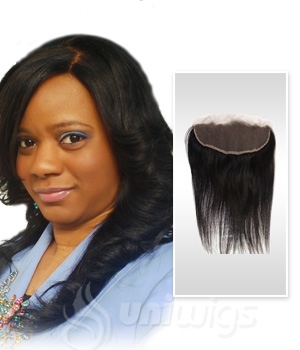Understanding the proper application of a lace frontal is essential to aesthetics and safety. Otherwise, the process may lead to hair loss and skin and/or wig damage. Unlike traditional wigs a lace frontal, commonly referred to as a “lace front wig,” features a mesh of Swiss or French lace constructed along its front perimeter. The hair along the perimeter of the wig is hand-tied onto the lace, allowing it to emulate a natural hairline. In addition, specially made adhesives are applied directly beneath the hairline of the wig in order to secure the lace frontal closure along the scalp.

1. Secure your hair so it lies flat underneath the wig. This can be achieved by two methods:
Cornrow braid your hair. Take the tooth end of your rat tail comb and part your hair into vertical sections one by one. Part in a straight line beginning from the middle of your hairline on back to the nape of your neck (how small you want your braids is determined by the width or amount of hair in between each part). Take three sections of hair left in between these parts and braid the hair into a cornrow. Repeat the process until all your hair is securely braided. Place the wig cap over your hair.
Tightly gather your loose hair. Comb or brush the hair back flat and away from your face. Pin the hair as you see fit. Place the wig cap over your hair. Tuck any loose strands of hair underneath the wig cap.
2. Wet a gauze pad generously with rubbing alcohol. Rub it along your hairline wherever adhesive will be applied so as to cleanse away dirt, oil and debris that may be on your skin. Allow the skin to air dry completely.
3. Apply scalp protectant as directed along your hairline wherever hair adhesive will be applied on the skin. Allow it to air dry completely.
4. Trace lightly where you would like the lace front wig to rest, using a makeup pencil, as you do not want the edge of the human hair lace front wig to lie directly over the hair at the hairline. To reasonably recreate the appearance of a natural hairline, trace no further than 1/2 inch away from your actual hairline.
5. Trim off any excess lace left around the hairline of the lace front wig carefully, using scissors. Cut all the lace off directly up to the hairline of the lace frontal.
6. Apply a thin coat of adhesive bond along the edge of the wig cap (this prevents wig cap from slipping backward while underneath the wig), in between the actual and traced hairlines, and along the nape of the neck. Do not apply the lace front on wet glue or it won’t secure properly. Allow “soft bond” adhesives to set or get “tacky” to the touch. However, “hard bond” adhesives do not require drying time as they dry immediately upon application.
To use adhesive tape cut the tape to the desired length. Firmly press the tape directly beneath the hairline of the lace front wig along your forehead and the nape of your neck. Allow small gaps in between the strips of tape so moisture can escape. Allow the tape to set for 5 to 10 minutes. Peel off the back of the tape to expose the adhesive.
7. Position the lace front wigs human hair on your head starting from the back and it lifting forward over your head. Keep the wig slightly elevated over the scalp so the wig won’t slide down onto the adhesive once you’ve reached your forehead. Line up the perimeter edge of the wig over the desired hairline or tape. Glue users press down along the entire perimeter of the lace frontal so as to secure it in place. Tape users press and hold the entire perimeter of the lace frontal for up to one minute.
8. Tie the scarf securely around your hairline to allow the wig to thoroughly bond to the adhesive on your skin. If the lace front is made of human or heat resistant hair you may sit under a dryer as long as needed to assist the bonding process — this is optional. Do not wash or vigorously manipulate the lace front wig for 24 hours.


